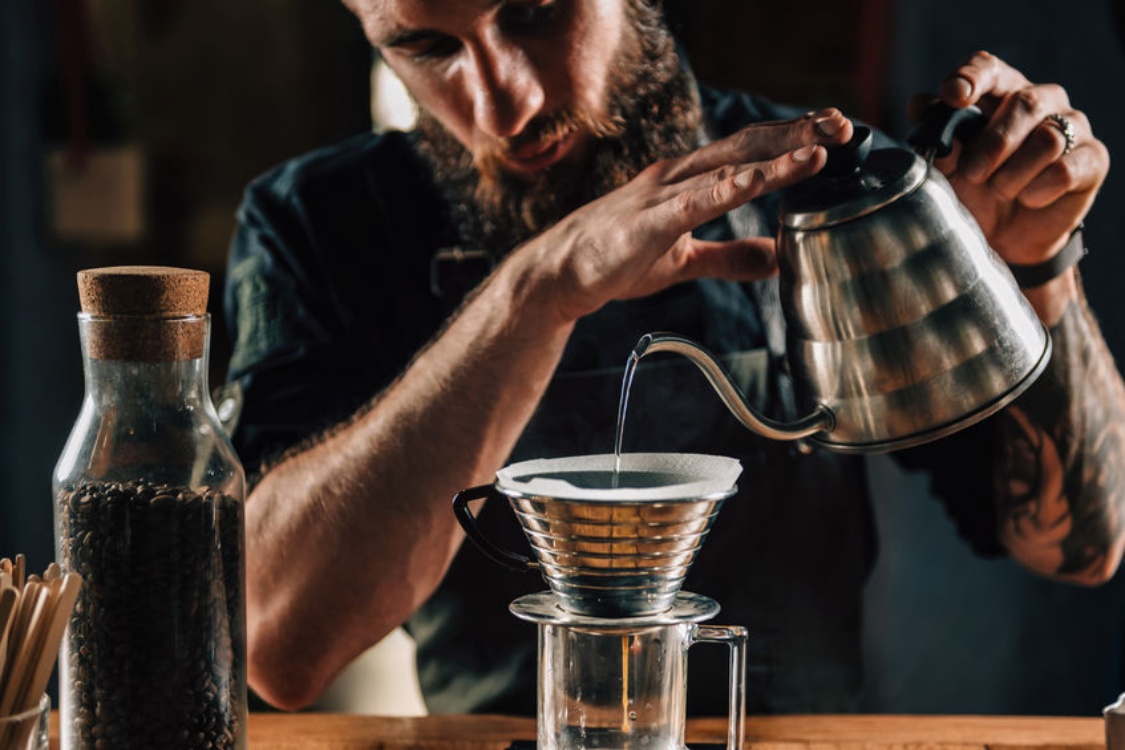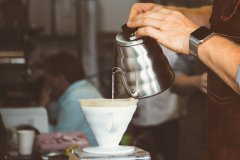Five methods must be learned for hand-brewed coffee beans and water quality requirements for hand-brewed coffee

Professional coffee knowledge exchange more coffee bean information please follow the coffee workshop (Wechat official account cafe_style)
There is always a kind of water in your heart.
When you have mastered the beans and water quality requirements for hand-brewed coffee described in the first two articles, you can then learn the blending skills. There are many ways to brew coffee by hand, of which the following five methods are the most commonly used. Go ahead and see which coffee tastes best for you.
● volcano rushes ●
The "volcanic flushing" technique, which originated in Japan, is suitable for deep roasting coffee beans because they contain more carbon dioxide and use the carbon dioxide in the beans to bulge like a volcanic eruption after many times of steaming. Most of the "Volcano Flushing" uses flannel filter cloth and V60 filter cup to cook. Because the middle powder layer is thick, water is injected in the middle of the coffee powder about the size of a 1 yuan coin. The first half is fully extracted under the non-destructive powder layer, while the second half is evenly injected with water to prevent the middle coffee powder from being over-extracted and diluted.
Advantages: the taste of coffee is mellow and sweet.
Disadvantages: excessive extraction in the first half and insufficient extraction in the second half, which makes the coffee liquid uneven. It must be fully shaken after brewing before it can be mixed into a perfect coffee. However, shaking well will lower the temperature of the coffee, and if you use high temperature extraction to maintain the temperature, it will make the coffee dry.
● loose house method ●
The Matsuya method, which also originated in Japan, focuses on the way in which delicious ingredients are extracted from coffee. Use a small spoon to dig a big hole in the coffee powder, about 30cm from the coffee powder noodles, pour water from the middle until the coffee liquid begins to drip, then draw a circle to wet the coffee powder, then cover it with steaming. After steaming for 3 minutes, begin to pour water evenly and continuously until the coffee liquid reaches half of the coffee pot, then add hot water to dilute it.
Advantages: can maintain the flavor of coffee, even if placed for a period of time, there will not be much change.
Disadvantages: some people think that the extraction time is too long, so that part of the coffee flavor evaporates.
● stirring ●
After barista Matt Perger won the championship in the 2012 World Brewing Competition (WBrC) with "stirring", this method of making coffee by hand became popular in Europe, America and Australia. To carry out the "stirring method", first grind the coffee powder to fine, inject about 50ml water, stir evenly back and forth in the cross direction, so that the coffee powder is in full contact with the water, 30 seconds later, and complete the water injection step within 2 minutes; if you use deep roasting coffee beans, you need to steam for 15 seconds before water injection, and complete the water injection in 1 minute and 30 seconds.
Advantages: it can magnify the advantages of coffee beans and enhance the taste, but not too thin.
Disadvantages: high requirements for the quality of coffee beans, if the use of poor quality coffee beans, will only infinitely magnify its bad flavor; in addition, coffee powder must be ground to very fine and fully stirred, improper control is easy to over-extraction.
● by ● drop method
As the name implies, it is boiled in the form of dripping water, which drips into the coffee powder like an hourglass. First wet the coffee powder bit by bit with water, then start injecting water after dripping about 1/3, stop when the water level of the coffee powder reaches its peak, and inject water again when the water level drops to half.
Advantages: drip method makes the sweetness of coffee beans more prominent and helps to remove the sour and bitter taste of coffee.
Cons: test your very stable grip and patience, delicate but time-consuming.
● academic Chong method ●
This is the most common way to brew coffee by hand, because the coffee made by hand has high taste stability, so it is the first choice for most coffee fans. This technique requires more demanding hand brewing pots, requiring delicate, vertical, stable and uniform water flow in order to brew a good cup of coffee. The method is simple: pour water out from the center of the coffee powder, then steam it, wait until the coffee powder collapses, and slowly inject water again from the inside to the outside.
Advantages: the finished product is stable, most filter cups are suitable for brewing, and it is an easy way for beginners to brew coffee by hand.
Disadvantages: many coffee lovers think that its advantages have become its disadvantages at the same time, and feel that the brewing method is too stable to form its own style and characteristics.
END
Important Notice :
前街咖啡 FrontStreet Coffee has moved to new addredd:
FrontStreet Coffee Address: 315,Donghua East Road,GuangZhou
Tel:020 38364473
- Prev

The key to making coffee by hand _ five factors for beginners to make coffee
Professional coffee knowledge exchange more coffee bean information please follow the coffee workshop (Wechat official account cafe_style) the key to making coffee by hand. There are many coffee shops on the street, some mainly focus on the interior environment or the decoration on the coffee, selling the overall atmosphere and style, but in addition to these decorations, fine coffee slowly rises by simple taste, people who taste the coffee itself.
- Next

Do coffee beans know the disadvantages of Robusta coffee beans? Talk about the appearance and taste of Luodou.
Professional coffee knowledge exchange more coffee bean information Please pay attention to the coffee workshop (Wechat official account cafe_style) Robusta and Arabica are the two main kinds of coffee in the coffee market; coffee beans like Arabica grow in the tropics at colder high elevations, so Robsta dominates the world below 600m above sea level. Robusta, the main attack.
Related
- Beginners will see the "Coffee pull flower" guide!
- What is the difference between ice blog purified milk and ordinary milk coffee?
- Why is the Philippines the largest producer of crops in Liberia?
- For coffee extraction, should the fine powder be retained?
- How does extracted espresso fill pressed powder? How much strength does it take to press the powder?
- How to make jasmine cold extract coffee? Is the jasmine + latte good?
- Will this little toy really make the coffee taste better? How does Lily Drip affect coffee extraction?
- Will the action of slapping the filter cup also affect coffee extraction?
- What's the difference between powder-to-water ratio and powder-to-liquid ratio?
- What is the Ethiopian local species? What does it have to do with Heirloom native species?

